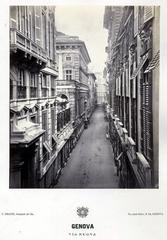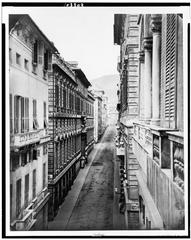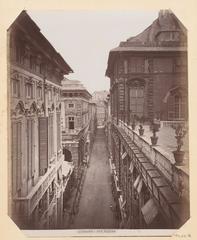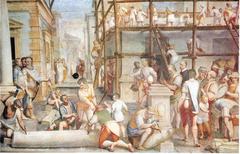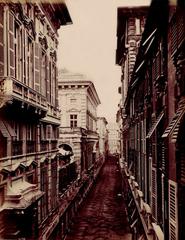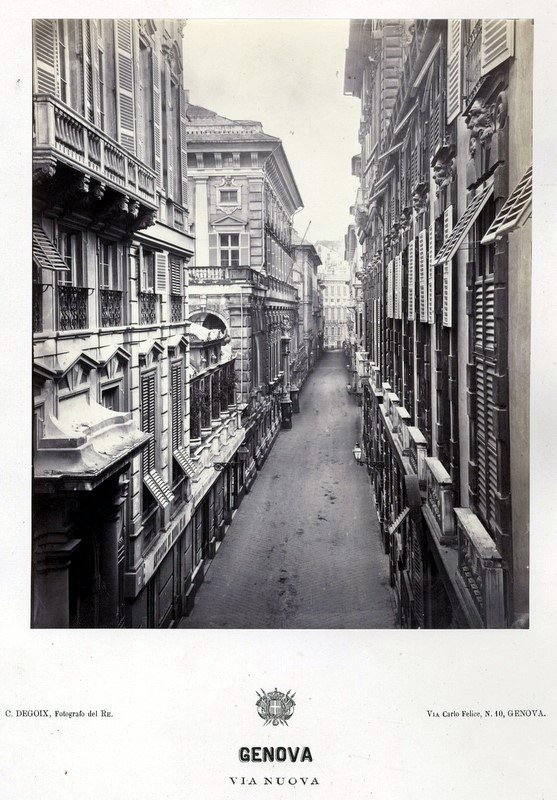
Via Giuseppe Garibaldi, Genoa, Italy: Visiting Hours, Tickets, and Historical Sites Guide
Date: 14/06/2025
Introduction
Via Giuseppe Garibaldi in Genoa is a celebrated emblem of Renaissance urban planning, aristocratic grandeur, and Italian cultural heritage. Originally called Strada Nuova, this elegant thoroughfare is lined with the Palazzi dei Rolli—sumptuous residences of Genoa’s nobility, now recognized as a UNESCO World Heritage Site. This guide offers a comprehensive overview of the street’s history, architectural marvels, practical visitor information, and must-see attractions, ensuring you experience the best of Genoa’s “Street of Palaces” (Wikipedia; Visit Genoa; Guida di Genova).
Table of Contents
- Introduction
- Historical Background
- Visitor Information
- Key Attractions
- Rolli Days and Special Events
- Nearby Attractions
- Frequently Asked Questions (FAQ)
- Conclusion and Recommendations
- References
Historical Background
Renaissance Vision and Origins
Via Giuseppe Garibaldi, initially Strada Nuova, was planned in the mid-16th century to break from Genoa’s medieval urban fabric. Construction began in 1550, authorized by the city’s aristocracy who envisioned a straight, wide avenue to display their wealth and influence (Wikipedia). Completed by 1583, its harmonious proportions and symmetry embodied Renaissance ideals, setting a new standard for urban design (Lucadea.com).
The Palazzi dei Rolli System
Central to the street’s history is the Palazzi dei Rolli system: a formalized list of palaces required to host visiting dignitaries. The Republic of Genoa established this system in 1576, choosing palaces through a lottery based on their grandeur and the owner’s status (Old Town Explorer). This unique mechanism reflected Genoa’s republican ethos and competitive aristocracy. Many of the most distinguished Rolli palaces, such as Palazzo Rosso, Palazzo Bianco, and Palazzo Doria Tursi, are found here, each notable for its art collections and architectural splendor (Visit Genoa).
Architectural and Artistic Highlights
The palaces along Via Garibaldi are masterpieces of Renaissance and Baroque architecture, featuring marble facades, ornate portals, grand staircases, and frescoed interiors (Visit Genoa). Notably, Flemish painter Pieter Paul Rubens published engravings of these palazzi, influencing aristocratic architecture across Europe. The transformation of many palaces into museums, notably the Musei di Strada Nuova, preserves their artistic and historical legacy.
Evolution and Modern Significance
The street, originally Strada Nuova and later called Via Aurea (“Golden Street”), was renamed Via Giuseppe Garibaldi in 1882 to honor the Italian unification hero (Wikipedia). In 2006, the Strade Nuove and Palazzi dei Rolli were inscribed as a UNESCO World Heritage Site, highlighting their global cultural impact (Guida di Genova).
Visitor Information
Visiting Hours and Tickets
-
Street Access: Via Giuseppe Garibaldi is a public street accessible 24/7.
-
Musei di Strada Nuova (Palazzo Rosso, Palazzo Bianco, Palazzo Doria Tursi):
- Open Tuesday to Sunday, 10:00 AM – 6:00 PM; closed Mondays and select holidays.
- Standard adult ticket: €10; discounts for EU citizens (18–25), free for under 18.
- Combination tickets available covering all three museums.
- Tickets can be purchased online or at the entrance.
-
Guided Tours:
- Available in multiple languages; advisable to book in advance, especially during high season.
- Special tours and access during Rolli Days (Visit Genoa Rolli Days).
Accessibility
- The street is pedestrian-friendly and mostly flat.
- Most major palaces offer wheelchair access; some historic areas may have limitations.
- For specific accessibility needs, confirm with each site before visiting.
Travel Tips
- Transport: Genoa’s main train stations (Piazza Principe, Brignole) are within walking distance. The Dinegro metro stop and several bus lines provide easy access.
- Parking: Use nearby facilities like Park Marina Porto Antico or Park Mercanzia; avoid driving in the historical center due to narrow streets.
- Attire: Wear comfortable shoes for walking; allow several hours for a thorough visit.
Key Attractions
Palazzo Rosso
A 17th-century palace renowned for its frescoes and art collections from Van Dyck, Veronese, and Dürer. The rooftop terrace offers panoramic views of Genoa.
Palazzo Bianco
Houses masterpieces by Caravaggio, Rubens, and other European artists in refined Renaissance settings.
Palazzo Doria Tursi
The largest palace on the street, now Genoa’s city hall. Highlights include grand halls and Paganini’s famed violin.
Palazzo della Meridiana
Famous for its trompe-l’oeil frescoes and restored interiors, it hosts exhibitions and guided tours.
Additional Palazzi
Palazzo Lomellino, Palazzo Podestà, and Palazzo Parodi are also notable for their architecture and occasional public access.
Rolli Days and Special Events
Rolli Days are biannual events (spring and autumn) when many Palazzi dei Rolli, including those typically closed to the public, open their doors for guided tours, exhibitions, and cultural activities. Rolli Days provide a rare opportunity to explore Genoa’s aristocratic heritage in depth (Visit Genoa Rolli Days).
Nearby Attractions
- Piazza De Ferrari: Genoa’s main square, known for its monumental fountain and neoclassical buildings.
- Cathedral of San Lorenzo: The city’s striking black-and-white striped cathedral.
- Porta Soprana: One of Genoa’s medieval gates, near the reputed home of Christopher Columbus.
- Old Port (Porto Antico): Redeveloped waterfront area with museums, shops, and the Genoa Aquarium.
Frequently Asked Questions (FAQ)
Q: What are the visiting hours for Via Giuseppe Garibaldi palaces?
A: Most palaces are open Tuesday to Sunday, 10:00 AM–6:00 PM; closed Mondays. Hours may vary during holidays and off-season.
Q: How much are tickets to the palaces?
A: Individual tickets range from €6–€12; combination tickets are available for the Musei di Strada Nuova.
Q: Are guided tours available?
A: Yes, guided and self-guided tours are offered in multiple languages. Book ahead for popular times.
Q: Is the street accessible for visitors with disabilities?
A: Via Garibaldi is mostly flat and accessible, but some palace interiors may have limited access.
Q: What are Rolli Days?
A: Biannual events when many palaces open for special tours and cultural events, often including rarely-seen interiors.
Conclusion and Recommendations
Via Giuseppe Garibaldi is a jewel of Genoa’s historic center, offering a unique blend of art, architecture, and living history. Its palaces, integral to the Palazzi dei Rolli system, provide an exceptional window into Genoa’s Renaissance and Baroque legacy. Plan your visit to coincide with Rolli Days for exclusive access, and consider purchasing combined tickets for the best value. To enrich your experience, download the Audiala app for guided tours and up-to-date visitor information.
